Pilates Cross-training for Climbers
As a climber, have you ever wished you were a little taller so you could make a big reach, or a little more flexible for a high step? Have you ever resorted to picking up your foot and placing it where you wanted it to go because you didn't have the flexibility to get there in the first place? By adding Pilates to your cross-training, you'll find that monster stems, killer high steps, and sketchy rock-over moves get easier. By practicing Pilates, you'll improve the quality of your fitness, reduce your risk for overuse injuries and improve your climbing. Not only will you log more pitches in a single day, you'll climb them in better style.
The higher the grade and the more you climb, the greater the stress load on your body and the more at risk you become for an overuse injury. Preventing overuse injuries means maintaining uniform muscle balance in the forearms, uppers arms, and shoulders. Muscle imbalances are responsible for many common climber injuries. Overly developed back muscles and underdeveloped rotator cuff muscles often lead to shoulder injury. Meanwhile overdeveloped flexors of the forearms and wrist paired with underdeveloped extensor muscles can lead to elbow injuries. To avoid climbing related injuries an effective Pilates cross-training routine should focus on achieving the following:
• Boosting Core Strength (abdominals, hips, and mid back).
• Improving flexibility.
• Restoring overall muscle balance.
• Strengthening non-climbing muscles (antagonists)
• Stretching climbing muscles (agonists).
Adding Pilates exercises to your current cross-training routine is easy. All you need is a flat space where you can lie down and move your arms and legs freely. Camping mats or pads work great. If you are using a yoga mat, it’s best to stack at least two together. If you’re outside in a park, picnic tables work great as practice space if the ground is wet, uneven, or sloping.
Here's are three excellent Pilates exercises for Climbers. Learn many others in Lauri Stricker's Pilates for the Outdoor Athlete.
Double Straight Leg Stretch
Purpose: Strengthens the Core Begin by lying on your back.
Stack your hands behind your head with you elbows bent and gently lengthen the back of your neck. Roll up to the base of your shoulder blades. Bring your legs perpendicular to your body. INHALE and lower your legs to 45 degrees. Imagine your legs are straight and solid as a strong board. Avoid arching your lower back. Keep your spine flat on the mat. EXHALE and lift your legs back to perpendicular, keeping your tailbone on the mat. Only lower your legs as far as you can while still keeping your lower back on the mat. (6-10 repetitions)
Single Leg Push Ups
Purpose: Strengthens the shoulders, chest, upper arms, and the core.
Begin by standing tall with your arms over your head. Hinge from your hips and lift one leg behind you as you lower your torso forward and raise your leg up father. Keep your hips square. INHALE, keep your leg extended, and walk your hands out until you are in a plank-like push-up position with your arms under your shoulders. EXHALE. Use a full breath for each one-legged push-up. Walk your hands back in and lower your leg back down as you hinge back up from the hips to an upright standing position. Repeat, standing on the opposite leg. Do 5-10 pushups per leg.
Rotator Cuff
Purpose: Improves shoulder strength and joint integrity.
Lying on your side, stack your hips and shoulders and bend your knees in at a right angle. Bend your top arm at a 45-degree angle with your elbow on your hip. INHALE and externally rotate your arm from your elbow so your hand moves away from your body. EXHALE and release it down slowly with control to the staring position. Maintain your sideline position; place the dumbbell in the hand of your lower arm. INHALE and internally rotate your arm from the elbow so that your palm comes up toward your shoulder. EXHALE and release it down slowly with control. (20 repetitions per side. Use a light 2-5 pound dumbbell).
 Lauri Stricker (pictured in photos) is an avid rock climber, and the author of the book: Pilates for the Outdoor Athlete, Fulcrum 2007.
Lauri Stricker (pictured in photos) is an avid rock climber, and the author of the book: Pilates for the Outdoor Athlete, Fulcrum 2007.
For more information on Pilates cross-training for climbing please visit: PilatesForTheOutdoorAthlete.com.
Click here to buy Pilates for the Outdoor Athlete from the Author!
The higher the grade and the more you climb, the greater the stress load on your body and the more at risk you become for an overuse injury. Preventing overuse injuries means maintaining uniform muscle balance in the forearms, uppers arms, and shoulders. Muscle imbalances are responsible for many common climber injuries. Overly developed back muscles and underdeveloped rotator cuff muscles often lead to shoulder injury. Meanwhile overdeveloped flexors of the forearms and wrist paired with underdeveloped extensor muscles can lead to elbow injuries. To avoid climbing related injuries an effective Pilates cross-training routine should focus on achieving the following:
• Boosting Core Strength (abdominals, hips, and mid back).
• Improving flexibility.
• Restoring overall muscle balance.
• Strengthening non-climbing muscles (antagonists)
• Stretching climbing muscles (agonists).
Adding Pilates exercises to your current cross-training routine is easy. All you need is a flat space where you can lie down and move your arms and legs freely. Camping mats or pads work great. If you are using a yoga mat, it’s best to stack at least two together. If you’re outside in a park, picnic tables work great as practice space if the ground is wet, uneven, or sloping.
Here's are three excellent Pilates exercises for Climbers. Learn many others in Lauri Stricker's Pilates for the Outdoor Athlete.
Double Straight Leg Stretch
Purpose: Strengthens the Core Begin by lying on your back.
Stack your hands behind your head with you elbows bent and gently lengthen the back of your neck. Roll up to the base of your shoulder blades. Bring your legs perpendicular to your body. INHALE and lower your legs to 45 degrees. Imagine your legs are straight and solid as a strong board. Avoid arching your lower back. Keep your spine flat on the mat. EXHALE and lift your legs back to perpendicular, keeping your tailbone on the mat. Only lower your legs as far as you can while still keeping your lower back on the mat. (6-10 repetitions)
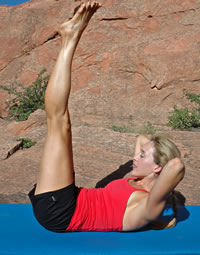 |
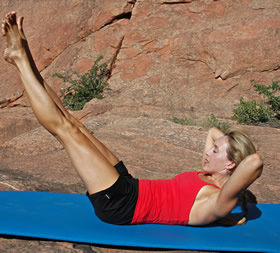 |
Single Leg Push Ups
Purpose: Strengthens the shoulders, chest, upper arms, and the core.
Begin by standing tall with your arms over your head. Hinge from your hips and lift one leg behind you as you lower your torso forward and raise your leg up father. Keep your hips square. INHALE, keep your leg extended, and walk your hands out until you are in a plank-like push-up position with your arms under your shoulders. EXHALE. Use a full breath for each one-legged push-up. Walk your hands back in and lower your leg back down as you hinge back up from the hips to an upright standing position. Repeat, standing on the opposite leg. Do 5-10 pushups per leg.
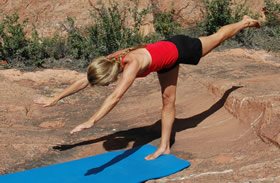 |
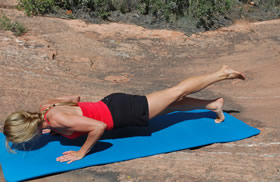 |
Rotator Cuff
Purpose: Improves shoulder strength and joint integrity.
Lying on your side, stack your hips and shoulders and bend your knees in at a right angle. Bend your top arm at a 45-degree angle with your elbow on your hip. INHALE and externally rotate your arm from your elbow so your hand moves away from your body. EXHALE and release it down slowly with control to the staring position. Maintain your sideline position; place the dumbbell in the hand of your lower arm. INHALE and internally rotate your arm from the elbow so that your palm comes up toward your shoulder. EXHALE and release it down slowly with control. (20 repetitions per side. Use a light 2-5 pound dumbbell).
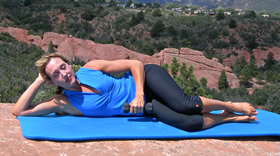 |
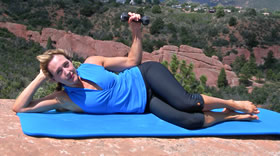 |
 Lauri Stricker (pictured in photos) is an avid rock climber, and the author of the book: Pilates for the Outdoor Athlete, Fulcrum 2007.
Lauri Stricker (pictured in photos) is an avid rock climber, and the author of the book: Pilates for the Outdoor Athlete, Fulcrum 2007.For more information on Pilates cross-training for climbing please visit: PilatesForTheOutdoorAthlete.com.
Click here to buy Pilates for the Outdoor Athlete from the Author!



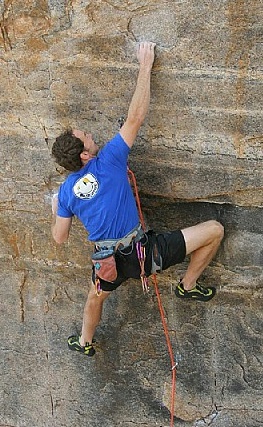 In the last few articles you’ve learned how performance operates from the inside-out. Your beliefs, focus, fears, confidence, motivation, and for that matter every thought that crosses your mind, form the foundation from which you will either succeed or fail on a climb. Therefore, succeeding on a project or advancing to the next grade level is often more a matter of the mind, than it is the body.
In the last few articles you’ve learned how performance operates from the inside-out. Your beliefs, focus, fears, confidence, motivation, and for that matter every thought that crosses your mind, form the foundation from which you will either succeed or fail on a climb. Therefore, succeeding on a project or advancing to the next grade level is often more a matter of the mind, than it is the body.  Subscribe to Eric's RSS Feed
Subscribe to Eric's RSS Feed
 Subscribe to Eric's RSS Feed
Subscribe to Eric's RSS Feed